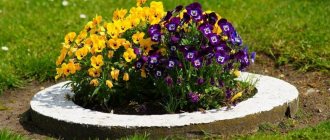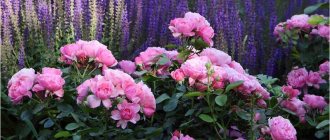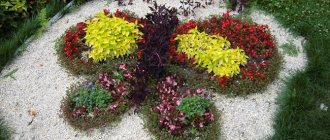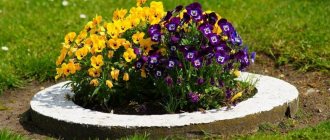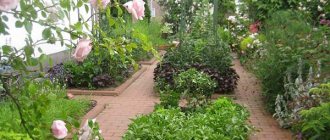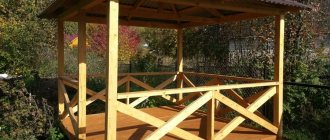- Rules for designing coniferous mixborders
- Coniferous mixborder layout options
- Coniferous mixborder: choosing a location and step-by-step site preparation
- Seasonal care for coniferous mixborders
- Video: how to create a coniferous mixborder
The coniferous mixborder is a purely English invention. The British decorated garden paths with elongated flower beds, marked the boundaries of plots, and decorated hedges. In such compositions, the basis is made up of perennials: low conifers and various shrubs, annuals serve only as an addition. When creating a mixborder, certain patterns and tiers are followed.
Rules for designing coniferous mixborders
This type of landscape design has gained particular popularity in recent years. Translated from English, mixborder is a mixed border that combines plants of different sizes. The shape of coniferous mixborders is determined arbitrarily.
Main types of coniferous mixborders:
- One-sided mixborder. Planted along walls and fences. The view is only available from one side. Plants form a “cascade” from top to bottom.
- Double-sided. The composition can be freely viewed from any side. Tall crops are placed in the center, low ones on the periphery of the composition.
One-sided coniferous mixborder.
Flower beds are divided by style: English, meadow, contrast, polychrome, monochrome, rustic. Conifers can serve as a background in any direction.
A mixborder made of conifers should always have clearly defined boundaries; they can be created using artificial materials or using a border of low perennials. Right angles and lines are avoided, leaving smooth and natural curves. Trees that are too tall are not used in the compositions, so as not to lose the view of the upper tier. For 1 sq. m of area are planted no more than: tall trees - 1 pc., medium-grown trees - from 5 to 8 pcs., low trees - 10 pcs., ground cover trees - about 50 pcs.
Planting in mixborders is not done in straight lines, but as it would look in nature. You should not place more than three different shades of pine needles in a row - this will create unnecessary mixing of colors. Play with height differences: the wider the flower garden, the more tiers you can create in the flowerbed.
Features of mixborders with conifers
Mixborders with conifers are flower beds of continuous flowering, which, if properly arranged, will delight owners with their attractiveness all year round.
The advantages of using conifers in mixborders include:
- ease of care;
- ability to get along with other plants;
- high decorative qualities all year round;
- durability;
- versatility. Such flower beds fit harmoniously into any stylistic direction of the garden, and become their main bright accent.
Attention : flower beds with conifers of emerald-bluish shades, planted next to lush summer flowers, look especially attractive.
Coniferous mixborder layout options
First, skeletal plants are planted in the selected area. The crops will determine the height of the future composition. As a basis for a small mixborder, choose:
Coniferous mixborder.
- cypress trees (compact and dwarf Lawson forms);
- blue spruce;
- Bergman pine;
- dwarf gray spruce, fir, thuja.
Trees are planted at intervals, taking into account the intensity of their growth. When the “scenery is in place,” they begin to fill the free space. The following are planted in the circles around the trunk:
- juniper (scaly, Chinese);
- evergreen boxwood (does well in light shade);
- Erica (plant of the heather family).
Helpful advice! To make a mixborder of conifers complete, the same varieties are used several times.
The next tier is spectacular plants. Typically, conifers are complemented by low flowering shrubs: jasmine, magnolia, rhododendron, tree hydrangea, spirea, barberry.
In the fall, when everything has faded, decorative foliage trees will delight the eye: turf, euonymus, Japanese maple, fieldfare. The very foreground of the mixborder is reserved for low plants: flowering perennials. If the mixborder is made up exclusively of conifers and shrubs, then the lower tier is filled with creeping ones: ivy, Cossack juniper, horizontal cotoneaster.
In coniferous mixborders, various artificial materials are used to mulch the soil. This will make it much easier to care for the composition and make it decorative. The following are suitable for this: gravel, wood chips, crushed bricks, tiles. Compositions and patterns are laid out from large stones; lighting elements in the form of lanterns and light bulbs will bring special uniqueness.
Coniferous mixborder.
Flower garden by the pond
Dwarf juniper is ideal for creating a border along a garden path. A composition of two types of this shrub gracefully frames the banks of an artificial pond.
In the foreground is planted juniper scaly variety Blue Star, one of the most popular perennials for rockeries and alpine slides. A Japanese dwarf juniper peeks out from behind a Blue Star bush.
On the left along the path is Perovsky swan-leaved, which adds an interesting lavender accent to the composition. The lilac theme is picked up and developed by catnip.
The unconditional dominant of this flower garden is the miscanthus bush of the Adagio variety. It can be replaced with lush blue lightning .
Also, hostas will be excellent neighbors with low-growing junipers, and astilbes can keep Perovskias company.
Coniferous mixborder: choosing a location and step-by-step site preparation
On the site for the future flower garden, evaluate:
- soil composition;
- humidity;
- degree of illumination.
For coniferous mixborders, a place that is not too sunny is given. Under scorching rays, the needles burn out and lose their decorative effect. The soil should not be too dry or swampy. If you are planning a mixed border of conifers as a hedge, then it is advisable to place the planting not near the windows - as they grow, large trees will be an obstacle to the view.
It is better to interrupt a strip of a flower bed that is too long without making it continuous. It looks more aesthetically pleasing, and caring for plants will be easier. 0.5 m are set back from the edge of the garden paths.
Helpful advice! When choosing a color scheme for a mixborder, warm shades are mixed with warm ones, and cold ones with cold ones.
The presence of conifers always emphasizes English severity and restraint in a mixborder. In such compositions, too catchy colors and lush shapes with wide leaves are usually avoided.
Coniferous mixborder.
Starting excavation work:
- The site is dug up in the fall, and fertilizers are added if necessary.
- According to ready-made diagrams, holes are made for conifers, shrubs and basic perennials. Distance between low and dwarf forms: 60–80 cm, between medium ones 1–1.5 m, between tall trees at least two meters.
- Lay out decorative elements.
Note! All seedlings are purchased only from trusted nurseries.
While the bushes are growing, in the spring you can plant annual crops: garden balsams, petunia, snapdragons, geraniums, asters.
Duet with sedums
The main advantages of juniper are its interesting texture and pleasant green coloration. Plants in lavender, burgundy, salmon, and coral shades complement this coniferous shrub to advantage. That is why juniper and sedum make a good duet.
In the photo on the left, Virginian juniper Green Aul is framed by red-leaved viburnum and sedum Autumn Joy. In the photo on the right, scaly juniper grows next to the sedum variety Dragons Tan.
Sedums and low-growing junipers can also be grown in a container.
The composition in the photo uses false sedum of the Bronze Carpet variety and Chinese juniper of the Saybrook Gold variety.
Seasonal care for coniferous mixborders
Shrubs and conifers do not require daily attention. Thanks to them, the intended composition retains its unchanged appearance for a long time. The following activities will help keep the flower garden at your dacha in an attractive condition:
- Trimming. Remove dried branches that spoil the appearance.
- Weeding. Despite the decorative toppings, the weeds “clog” the cultivated plants.
- Feeding. Complex mineral and organic fertilizers are necessary for coniferous and shrub mixborders.
Coniferous mixborder of shrubs.
- Protection from frost and sun. Many conifers need shelter for the winter; the bright winter sun will also damage the trees.
- Prevention and treatment of diseases. An outbreak of a viral infection can destroy the entire flower garden.
Decorative pruning of coniferous trees will make the finished composition even more unique. Cypress, fir, and thuja respond well to this procedure, and spruce crowns can easily be formed.
If your coniferous mixborder unobtrusively descends to a pond, then the following would be useful: daylilies, hostas, and ornamental cereals. Interesting ideas for placing creeping flowers with long shoots in large vases. This is convenient when planting a plant in the ground is not possible.
By designing a composition with your own hands, you will feel like an artist, an architect, and a chief engineer of land works.
Conifers for hedges: harvesting seedlings
Conifers are propagated by cuttings, carried out exclusively in greenhouses, because frost-resistant plants love warmth very much in the initial periods of their life. It is better to plan planting in early spring, when the buds are just swelling. During this period, vital juices reach their peak, which allows them to better “cling to life”, germinating more efficiently. There are two types of cuttings: lignified, green. Lignified ones grow faster, cuttings are taken in greenhouses in the fall and winter. Most of them take root safely after two to three months, if the watering and fertilizing system is properly balanced. Decorative forms are often grafted, but it is much more difficult for an amateur gardener to carry out such a procedure.
Trimming living fences made of coniferous plants
Trimming freshly planted trees is not recommended. It is only possible to trim the bushes on the sides; it is better to leave tall species for several years of quiet growth. If the tree is ready in all respects and is growing well, it is better to trim it with special pruning shears in spring or autumn.
- If they have reached the age of three, cut off the top by a third of the annual growth. Spruce plantings are perfectly pruned and usually feel good after pruning. The main thing is not to trim more than necessary.
- Pine trees are pruned in May and early summer, by pruning into rings. This is due to the appearance of young growth during this period. This type of pruning is associated with the appearance of inactive buds. The tree spends its vital juices on them, which it could spend on younger shoots. By carefully cutting off non-growing shoots, new buds gradually appear, forming fresh shoots. This process is also called plucking. Along with pine trees, it can be carried out in the spring.
- Hedges grown in free form, without pruning, are very susceptible to breaking the tops. You especially need to monitor this in winter if there is a lot of snow. It is shaken off the tops of the heads, the tops themselves are trimmed a little. This operation is related to the location of the fault. By cutting off a little of the top in advance, you can save the entire branch.
When cutting your hair and adding texture to your appearance, the main thing is not to “grab” too much, otherwise it will go up even more slowly. Coniferous species are very gentle towards shoots and buds, so it is generally better to avoid the vegetative period.
Feeding a hedge of coniferous trees
Conifers are unpretentious in many respects, until it comes to the soil. Ordinary fruit and berry trees in plots grow much more readily in unfed soil, adapting their rhizomes. Cypress trees, junipers, and thujas, on the contrary, compensate for the ease of care for them with a complex planting system.
- The soil for each plant is selected individually. Pines like sandy soil, spruce - clayey, junipers - slightly acidic. The same priorities include not wanting to grow in salty soil, the soil should be neutral.
- You should never fertilize conifers with manure; it burns the rhizome. Sawdust and natural compost are perfect.
- Nitrogen and phosphate fertilizers are useful. Young plants are fertilized starting in spring, including August; as they grow, the dosage must be increased.
- There are tablet fertilizers that are used once a year.
- Before the start of autumn, fertilizing stops, because the plants need to independently prepare for winter.
Diseases of coniferous plants
The plants described by the species are very unpretentious, but they are also loved by various diseases and are periodically attacked by pests.
- The most famous garden enemy is aphids. In the spring, with high soil moisture not associated with watering the garden by the gardener, favorable conditions are created for the life of this insect. If the problem is not caught in time, trees and shrubs can be seriously damaged. Spraying with decis diluted in water helps, sometimes it is replaced with fastak.
- A major challenge is the formation of rust. This is a special type of orange plaque that affects trunks and sometimes branches. The disease spreads from mountain ash, pear, and hawthorn, so it is better to immediately plant these trees and bushes further away. If an infection has occurred, you can try to remove it with saprol, dithane, spraying with solutions according to the instructions.
In general, there are few diseases, which is why hedges made of coniferous plants are very popular. There are rows of wood mites, molds that can overcome trunks, branches, even fruit. Additionally, prevention can be carried out to prevent the occurrence of diseases; sometimes gardeners act based on the current situation. It is difficult for non-professionals to immediately guess which trees to plant nearby and what to spray with. Conifers are good for their longevity and slow reaction, so you can try to save a diseased tree.
Features of planting a hedge of coniferous plants
The construction of a coniferous planting occurs in a similar way to the construction of ordinary fences, with a dug foundation and reinforcement. Before starting work, you should understand that thorny trees can interfere with passage, so you should carefully select seedlings and plan your planting plan more clearly. Only all materials are exclusively natural.
- It is necessary to mark the area where the fence will be located. Of course, you don’t have to take absolutely accurate measurements, similar to markings for fences; it’s enough to simply outline the territory, initially marking one line, then give it the shape of a trench that will be dug.
- The choice of location builds to organize, taking into account the needs of conifers. They grow poorly in strong shade; all biological species require sunlight for high-quality photosynthesis, but they burn out under direct rays. There are, of course, individual differences that need to be taken into account.
- It is recommended to dig one trench for all the trees at once. The task may seem difficult at first, but making individual holes will be much more difficult. It is also much easier to plant plants evenly in one dug hole. This method has the highest priority if seedlings are purchased at a time.
- The depth of the trench must be at least 70 centimeters. This question largely depends on the size of the roots. They cannot be twisted or bent too much, so you should dig a hole according to the comfortable location of the root system.
- The lower part of the “foundation” is drained with sand, maybe a little fine-grained pebbles. This will prevent stagnation of water, especially during cold periods, protecting the roots from rotting. Coniferous plants can be compared to house cacti - they are unpretentious, but they need water. Watering is organized systematically, approximately once a week.
- After preparing the hole, seedlings are planted. The minimum distance between plants is 80 centimeters; it is necessary to consider in the future the rapid increase in the size of the bushes, especially for trees. After planting, each tree (bush) is covered with earth and compacted. It is dangerous to press the ground too hard; you need to leave a little looseness to allow air to penetrate.
- Mulch is laid at the roots. There are different types: at the base of large plants you can fill in fine pebbles or old tree bark.
- The soil at the roots has to be lightly loosened from time to time so that the roots are better saturated without drying out.
- If the needles are on the sunny side in the hot summer, the needles may turn yellow. To avoid this, there are special aerosols that help the needles maintain their original appearance and prevent shedding. You can buy them at gardening stores, but they are quite expensive. A cheaper way is to cover it with ordinary burlap during the summer heat.
- In the southern regions, it is more important to plant in the fall, and in the northern regions in the spring. Plants with a closed root system are planted all year round.
Types of conifers for hedges
It is difficult to find fast-growing varieties of conifers adapted to any environment. A hedge becomes an excellent addition to a site when the seedlings are at the right distance and the species are perfectly selected. It is much easier to combine areas that can be formed without human intervention. Of course, almost all conifers planted separately look great. Some are much better at making hedges. Below are the most popular types of conifers:
- Prickly spruce forms impenetrable thorny hedges and grows widely, so it is advisable to plant it at a distance of up to 1 meter. It grows slowly and tolerates urban conditions well. The needles are blue, with a silver tint.
- Norway spruce tolerates shearing well, but if planted at intervals of forty centimeters, the hedge will be so dense that it can practically not be trimmed. It grows slowly in the first decade, although otherwise it is the best planting for a hedge.
- The common juniper has soft fluffy branches, grows up to 10 meters - it is perfect for hedges, low-growing forms complement borders. Low exposure to pests.
- Virgin juniper tolerates pruning well, retains its shape for a long time, only the sides are pruned. The dark blue cones look great and give the hedge a richer appearance.
- Cossack juniper is more of a border, low-growing type. Suitable for single-row plantings due to the wide crown. Requires a minimum planting density of about forty centimeters.
- Western thuja maintains its shape for a long time, it is planted close, also about forty centimeters. Reaching seven years of age, the branches become denser, intertwining into one large hedge.
- Oriental thuja has soft needles and fluffy branches. Characteristic for the most arid regions due to its endurance.
- Yew berry is considered the best material for topiary art. Perfectly withstands any, even the most complex, shaping haircut. The forms can be high, used instead of fences, or low, complementing borders. It grows very slowly, less than three centimeters annually. At the same time, it is durable and unpretentious. Tolerates bad city polluted, dusty air. Resistant to pests and diseases.
Along with formed hedges, free-growing hedges are popular. Accordingly, the plants must stretch straight on their own, without constant care or trimming. These qualities are mostly possessed by:
- Gray conical spruce , planted at 1 meter intervals, forms beautiful living, thorny green fences. Mature plants are very lush. The crown is beautiful, with a classic pyramidal shape. At the same time, the dimensions are significantly small, stretching up to a maximum of six meters. Drought-resistant, light-loving, adapts well to arid soils. Prefers good drainage, slightly acidic soils. Sometimes it is damaged by aphids and wood mites; both diseases can be cured on your own.
- Siberian fir creates entire living walls. In the spring, imports are formed, which turn into purple cone berries closer to summer. Prefers medium moisture soils saturated with fertile enzymes. They are disease resistant and grow well in coastal areas.
- Mountain pine is more suitable as a complement to borders and low hedges. Trimming does not produce additional branching growth. Seedlings are planted at a half-meter distance, are drought-resistant, undemanding about the type of soil, and live well in an urban environment. The flowering period is associated with the formation of pink and yellow strobiles.

